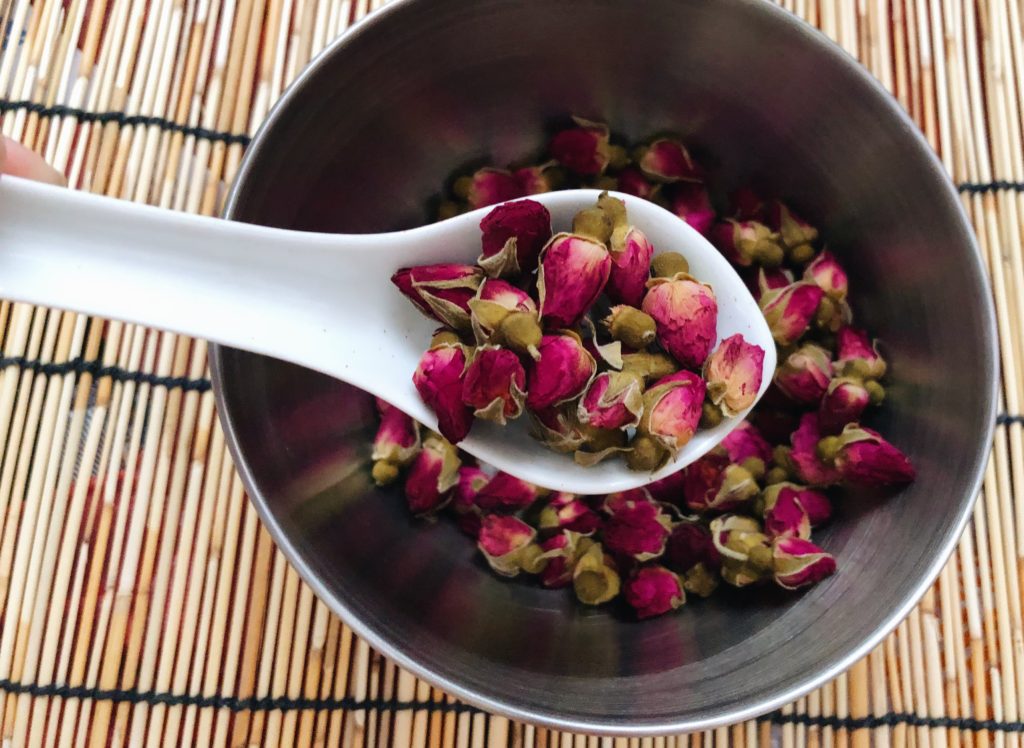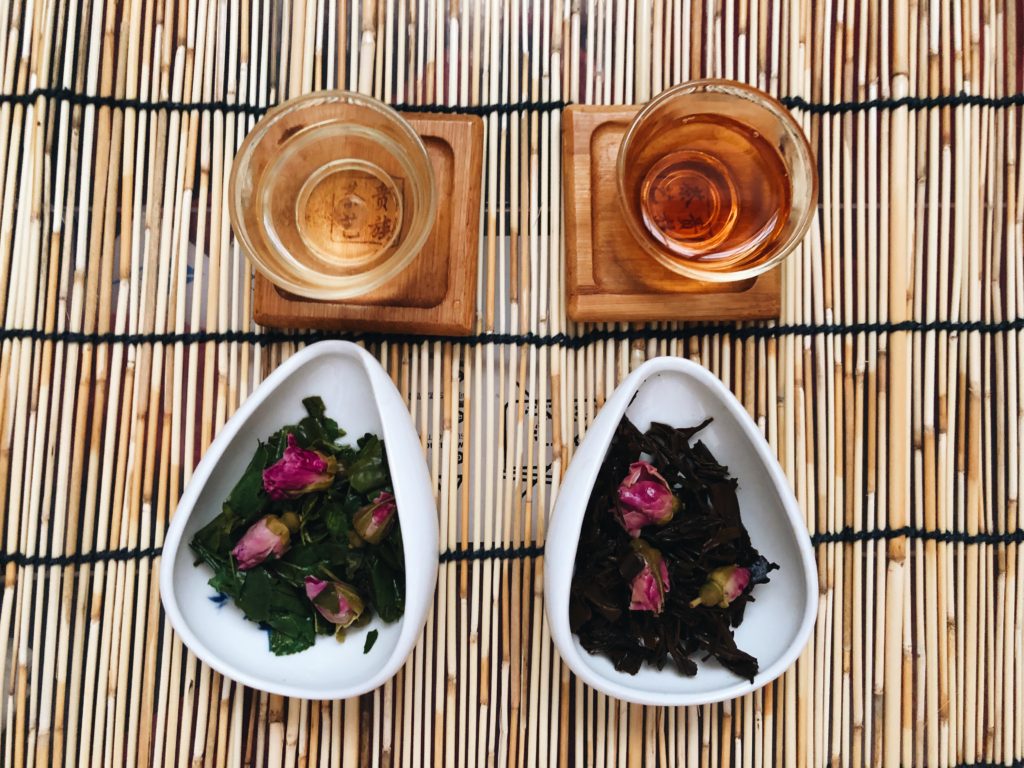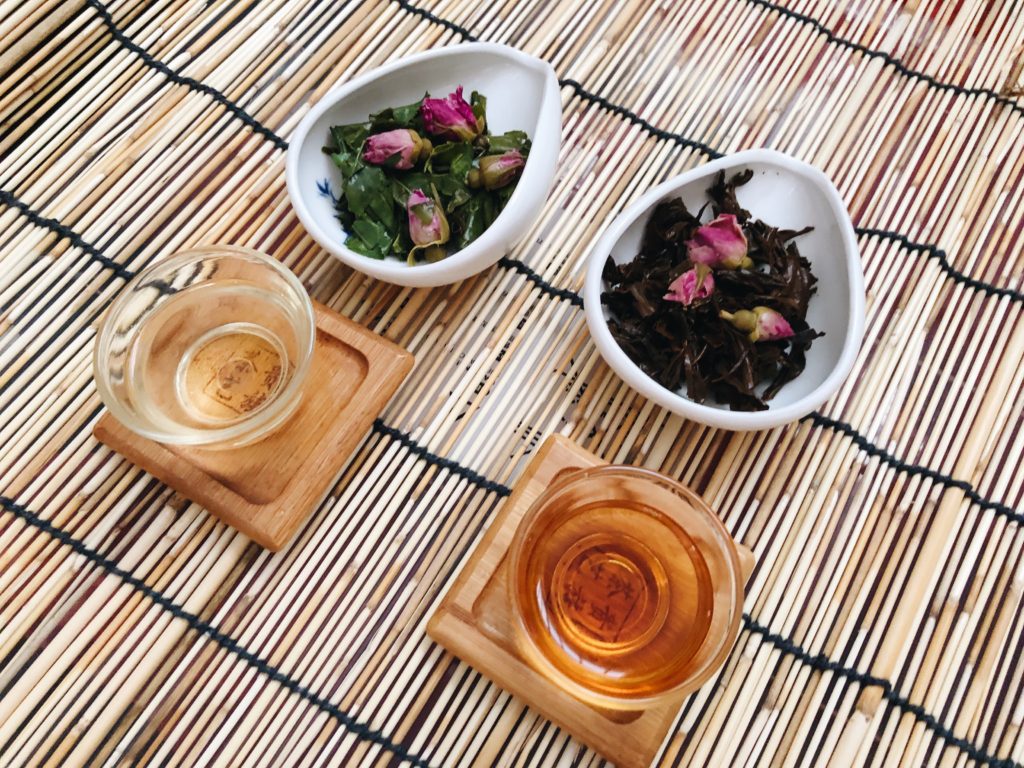When my cousin asked me about getting a tea bar for his wedding, I decided to volunteer. Or rather, I decided to ask Cher about it and we volunteered to do it, reasoning that with Cher’s contacts and my um… ability to plan, we could do a tea bar at a low cost. Well, the wedding is coming soon, so Cher and I had a meeting recently to finalise the proposed teas and come up with a tea blend for the wedding. Initially, we were going to have the guests blend their own tea, but my cousin suggested that we come up with one blend that we could serve so that guests won’t be confused about what to do with the tea.

Cher has this really gorgeous bowl of rose buds, which will be the tisane option for the tea bar, so we decided to do a rose-based blend. Since we’re trying to keep costs low, we decided to experiment with the black (Keemun Black Tea) and green (Liu An Gua Pian) teas that we’ll be serving. We figured that if we could create four choices from three types of tea, we’d be able to benefit a little more from economies of scale.
Rose + Keemun

Our first blend had a rose to tea ratio of 1:4. We probably sabotaged ourselves a little by steeping the tea immediately after blending instead of letting it sit for a while (we’ll probably have to do some fine-tuning before the event to determine when to blend it), but the rose notes for this was very faint. We tasted mostly keemun.
Emboldened by this, we increased the rose to tea ration to 1:3. For some reason, I really felt the astringent notes here but the rose still wasn’t very strong.
We found that the rose notes were best in a 1:2 ratio. The rose was strong but not overpowering and we noted some pleasant bitter notes at the back of the throat.
Rose + Liu An Gua Pian

While we liked the final 1:2 rose to Keemun blend well enough, we decided to try this with the Liu An Gua Pian as well. As with the Keemun, we started with a 1:4 ratio of rose to tea. We couldn’t taste the rose here – the tea was basically Liu An Gua Pian. It did, however, look just like a garden, which was lovely.
At a ratio of 1:3, the tea started to taste a bit different. But unlike the rose and Keemun blend, we couldn’t quite taste the rose yet. At this point, we were leaning towards the rose and Keemun blend as the one that we’d serve the wedding guests.
But everything was turned on its head when we tried the rose and Liu An at a 1:2 ratio. I felt that the rose notes were finally distinct and managed to hold its own against the green tea. Cher managed to get some melon seed notes, which was a pleasant surprise for her.
To be honest, neither Cherine nor I actually entertained the thought of blending the rose with Liu An Gua Pian when we first started our experiment. We’ve had more flavoured black teas than anything (and I’ve been drinking the Twining’s Golden Rose Hearts) so we just assume that black tea was the better base. But while the 1:2 ratio of rose to black tea was great, it didn’t give us new notes – like the melon seeds for Cher – and ultimately, didn’t wow us like the 1:2 ratio of roses to Liu An Gua Pian.
Next experiment (date to be determined, so it might be a while): how long should you let a tea sit after blending before steeping?

Interesting experiment! My understanding is that tea leaves more readily pick up aromas and flavors while they are still soft and moist, before they are dried. We tried letting black tea leaves sit for a couple weeks in a used whiskey barrel, and although the leaves smelled very aromatic afterward, they didn’t impart any whiskey flavor when brewed. Roses, however, have such a strong aroma that it seems that the tea leaves would pick up flavor over time.
Ooooh, interesting! In that case, we might need to start blending the tea a couple of days before the wedding (assuming that most guests would drink the tea in the week after). I wonder if green tea would pick up the aroma slightly quicker too, given that it has a comparatively higher water content.
I would think that you’re right about the green tea. Black tea has already been so oxidized and dried that I’d guess that it’s on the impenetrable side.